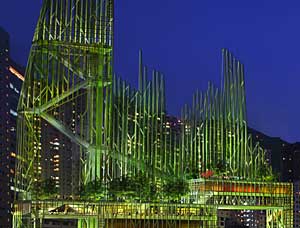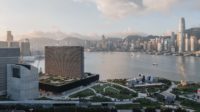Correction appended February 14, 2008
Hong Kong is a jungle of high-rise buildings, so it may come as a surprise that architects and preservationists there are objecting to plans for a tall tower designed by Herzog & de Meuron. The Swiss firm was hired by a local nonprofit to transform the city’s old Central Police Station compound into an arts and culture complex—but after a backlash against the scheme the Hong Kong chapter of the American Institute of Architects (AIA) stepped in and is holding a charrette next week to identify other viable designs.


Nestled in the city’s downtown financial district, the 3.6-acre police compound’s low-slung courthouse, barracks, and cell blocks were shuttered in 2006. The Hong Kong Jockey Club Charities Trust is negotiating with the Hong Kong government both to invest in the site’s redevelopment and to manage the compound for three years before handing it over to officials. It tasked Jacques Herzog and Pierre de Meuron with preserving all but a few of the current structures and connecting them to each other as well as the colorful surroundings.
In the architects’ re-imagining of this formerly forbidding site, the signature piece of new construction will be a tapering, skeletal tower that supports program elements including an auditorium, a recital hall, two theaters, and an observation deck. To provide a suitable vantage point, the tower must rise above its nearest neighbor, a 38-story office building.
Despite the tower’s height, its massing will be almost nothing thanks to a latticework structure. “We want to keep its transparency, to make these cultural places be visible from the outside so everybody can see this is the place for us to go,” Herzog said during a press event last October. He added that this see-through high-rise will create a dynamic contrast to its context of barbed wire and stone walls, which will be retained as part of the compound’s landscape scheme.
But with conceptual plans calling for the tower to rise between 426 feet and 525 feet tall, talk about its transparency does little to persuade critics. They contend that an addition of such height is inappropriate. “The tower is going to ruin [the historical site],” says Margaret Brooke, chairwoman of Heritage Hong Kong, a group that formed to preserve the compound before the Jockey Club made its own offer to the government. “We object to the effort of trying to turn it into something it never was. This is not a place for overseas architects to make their mark.”
This rationale couldn’t be further from the architects’ intentions, according to de Meuron. “We are not doing this just for us. This would be ridiculous to do it just for us,” he said last fall. “What can be worse than when a building is not accepted.”
The Jockey Club has until early April to gather public comments on the design and present them to the government before it gives the final go-ahead. The non-profit is planning to spend $230 million on the project. But club officials already say they will abandon it altogether if the new tower is nixed. Meanwhile, the local AIA chapter is holding a charrette on February 16 to solicit ideas that might be more palatable and appropriate to the historical context.
The police compound boasts a storied past. Its courthouse and police barracks, which date to the 1860s and early 1900s, are well preserved and feature many Greek Revival and Classical Revival architectural details. The cell blocks stand witness to the jailing of political activists, including Sun Yat-sen, the father of modern China, as well as bloody executions.
Local architects and preservationists contend that the compound’s revitalization requires minimal intervention. They point to the recent transformation of another colonial-era barracks into a history museum. In January, the United Nations Educational Cultural and Scientific Organization presented the Hong Kong government, which spearheaded that project, with an award for outstanding integration of contemporary architecture into a historical context.
Correction:
In addition to examining the Central Police Station site, the AIA Hong Kong’s charrette on February 16 is also inviting architects to consider the old Police Married Quarters. The chapter has no intention of opposing or supporting any proposal that is made for the development of either of the two sites, but rather aims to raise awareness of the issues of heritage conservation.




Post a comment to this article
Report Abusive Comment